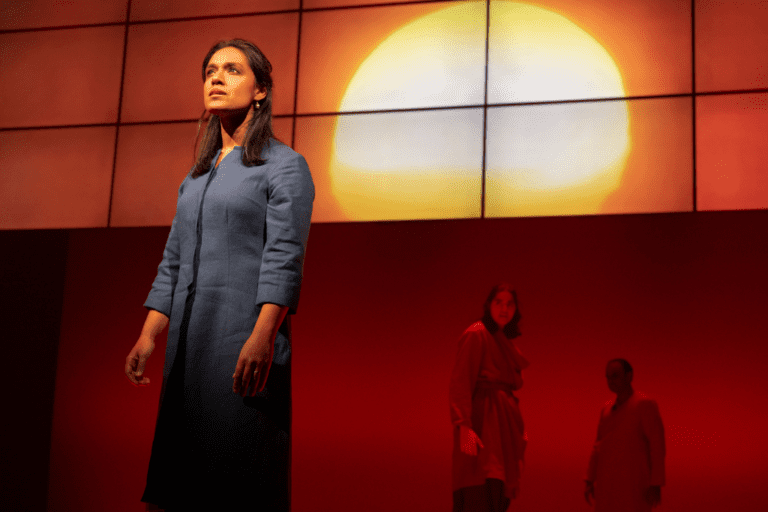‘Props come with no instructions’: How the Grand and Theatre Aquarius’ Waitress brings diner food to the stage
“Sugar. Butter. Flour.” The first words of composer-lyricist Sara Bareilles’ 2016 musical Waitress don’t just pull the audience into the world of the story but describe tangible props that appear in the show.
Set in Joe’s Diner, where protagonist Jenna bakes pies and waits tables, Waitress poses a challenge to directors and designers: How do you bring restaurant food to life onstage every performance? Ahead of the musical’s upcoming run at Hamilton’s Theatre Aquarius (the show is a co-production with London’s Grand Theatre, where it premiered in March), I spoke with the production’s props and scenic design department to find out how they’re making the pie magic happen.
Scenic designer Scott Penner, the Grand’s head of props Natalie Kearns, and Aquarius’ head of props Ashleigh Serge, discussed with me in separate Zoom and in-person conversations how props (real and fabricated) are designed and implemented, and how their use enhances the narrative of Waitress, making the production unique and memorable.
In the early stages of production, Penner was given a large creative package that included detailed prop lists and visual references from previous productions. He created a miniature stage design called a maquette to help determine the show’s look. He and Kearns then collaborated on what needed to be purchased, built, or sourced from the Society of Prop Managers.
“My role is to research, process, and help obtain what is needed for each production,” explained Kearns, who’s worked as head of props at the Grand for 11 seasons now. “Props come with no instructions. A lot is experience, some is experimenting, and some is networking and knowledge sharing.”

At the Grand, prop handling always begins fairly early in the rehearsal process. In the case of Waitress, where the actors are handling real food-based items — including eggs and measured liquids — many of the show’s props were implemented from day one.
“We like to introduce props and any items the actors will be working with as early as possible,” said Penner. “In a musical of this scale, they have a lot on their plate — learning lines, music, choreography, blocking, and transition changes — so giving them time to acclimate to the objects they’ll use onstage is always beneficial.”
While musical theatre is sometimes associated with fantasy, many contemporary audiences are seeking an authentic or “lived-in” experience on stage. When asked about how prop use accomplishes this, Kearns said that she thinks fantasy and realism both have a place in musical theatre, and call for different approaches.
“Realism means making choices about objects intentionally to tell the audience something about a character or a place.” Kearns explained. “For Shrek the Musical, as an example, no one is really thinking a lot about what colour Shrek’s coffee cup should be, [but] in the real world, it’s a lot of smaller details… What do the menus look like? How worn and stained are the diner booths?”
Penner explained that the entire story is “enveloped in detailed props and set dressing. By creating a container for the story where the entire world is built using shelves from Jenna’s pantry, we are transported to the space where she has her most vulnerable thoughts and dreams her biggest dreams. These props aren’t just decorative — they are integral to the story.”
Kearns suggested that the opening scene of Waitress should “feel like a functional diner, showing a morning rush at the diner and establishing the world of the play.” And as she guided me through the backstage area of Theatre Aquarius, Serge noted that props should never outshine a performance but enhance it. “We have to source believable props and set dressing to help create a world that could be a real place,” she said.
With equal amounts of enthusiasm, Penner, Kearns, and Serge each shared their favourite prop use moment in the show. Kearns and Serge mentioned an unexpected moment with a guitar, while Penner highlighted a sweet scene with a seemingly simple bouquet of flowers.

In Waitress, audiences see many sequences of protagonist Jenna creating pies in her mind, with some of those cheeky creations becoming real. The pies are made of pudding and cream and are consumed on stage. When I asked Penner, Kearns and Serge about their favourite Jenna pie creation, there was a passionate tie between “Life’s Just Peachy Peachy Keen” and the colourfully creative “Marshmallow Mermaid.”
After our discussions, it became abundantly clear to me that props are more than just things actors hold. Props add depth, realism, and visual elements to the storytelling. They help establish the setting and define characters, creating a fully realized world. As Penner concluded: “Whether it’s a simple hand prop like a mixing spoon or an elaborate set piece like our multiple shelves of baking equipment, props contribute to the authenticity of the performance, allowing the audience to engage more fully with the narrative.”
Waitress runs at Theatre Aquarius from April 30 to May 17.
Amanda Cosby-Nesbitt is a participant in What Writing Can Do: The 2025 Musical Theatre Critics Lab, a collaboration between Theatre Aquarius’ National Centre for New Musicals, the Grand Theatre, and Intermission.









Comments